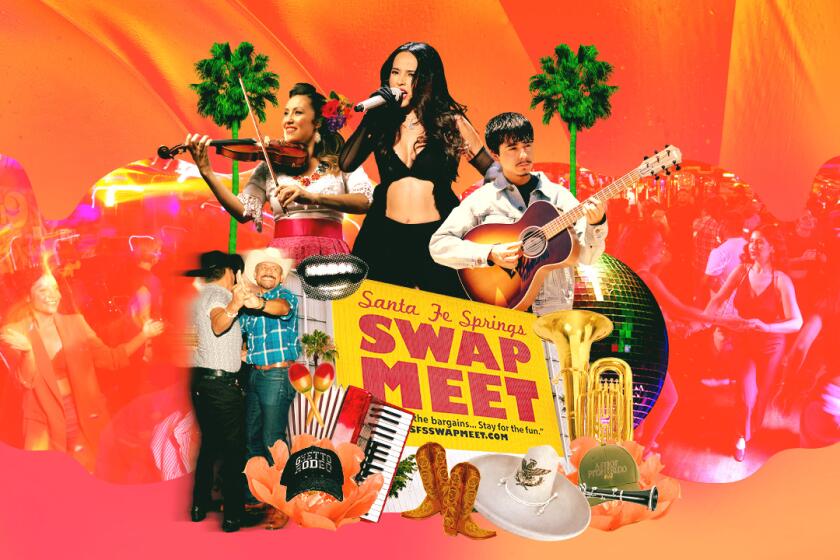
- Share via
Unlike many of his contemporaries, Manuel Turizo needs no moniker to flex his sweet baritone vocals. It’s a point of pride for the 24-year-old Colombian singer, to be as true as he can to himself.
“From my name, which is my birth name, to every concept that I’ve realized in my albums, it all relates to my lived reality,” said Turizo. “That’s why I think I am able to connect with people.”
Now, with the release of his fourth album, “201,” Turizo delves further into his Caribbean roots and pays homage to his vibrant hometown of Montería.
“I wanted the songs to sound like backyard parties with your people, dancing, rejoicing, drunken spirits who can’t deal with life but feel happy anyway, like two lovers kissing each other,” said Turizo to The Times.

The album includes features by Colombian reggaeton star Kapo, vallenato singer Elder Dayán Diaz, reggaeton legend Yandel, the música Mexicana quintet Grupo Frontera, Spanish trap singer Saiko and Brazilian DJ Alok. The LP incorporates tropical rhythms, blends of vallenatos (Colombian folk music) laced with urban beats and elements of rock, sonic earworms of lively celebrations. Its release comes two years after Turizo topped the charts with “La Bachata,” one of the most-streamed Latin songs with nearly 2 billion streams on Spotify.
Though no tour is set yet following the release of “201,” the singer is scheduled to perform at Calibash on Jan. 18 at Crypto.com Arena.
We caught up with Turizo ahead of his album release. The following interview has been edited for clarity and length.
You’re almost at 2 billion streams with “La Bachata.” Did you ever imagine it would blow up the way it did?
Since my first album “ADN,” I’ve played with many styles of music, pop, reggaeton, then reggae. After some time, my listeners have started to realize that I am versatile. So I feel like “La Bachata” was very liberating for me. I always liked the song! But obviously when you start talking to the team, there were people who didn’t see it. In fact, they’d say, “No, that’s not the right song.” But you have to be confident in what you think, what you feel, even if I didn’t see how big it was going to become.
I’m surprised that this new album isn’t a bachata-only album after that megahit!
I know that bachata is a style that my community of listeners like. But at the same time, I want to keep discovering sounds that I can share with people and say, “you see, you didn’t know you could like this sound and now you do! I know that y’all like this flavor of Manuel, but let me keep finding new flavors that you will like too!”
Also, how boring would it be of me to say, “Okay let’s do Bachata 2.0, 3.0, 4.0…” Then at that point I’m not letting the ideas flow. I want to live the music, I want to relish what I believe in and my ideas.
Música Mexicana has been pushed into the mainstream over the last five years by Gen Z and millennial Latino audiences. Here’s a guide on the genre’s essential instruments, where to find the best música Mexicana-themed parties, where to shop for the perfect vaquero outfit and more.
Tell me about your new album “201.” What was the inspiration behind it?
Imagine that you land in the Caribbean, it doesn’t necessarily have to be my Colombian Caribbean — though I would prefer it, but what it sounds like to me is parties, people, energy, what I experienced growing up, my culture, what I represent sounds like “201,” my home.
I wanted the songs to sound like backyard parties with your people, dancing, rejoicing, drunken spirits who can’t deal with life but feel happy anyway, like two lovers kissing each other. That’s where I drew inspiration from, my home, that’s why I put the numeration of my home, 201. But I want people to draw their own inspirations based on their individual lives!
You consulted with Edgar Barrera, a 21-time Latin Grammy winner, on some songs. How was that experience?
I feel like he is very in tune with me and knows how to guide me well in helping me craft the message that I want to deliver. We clicked well together. It could be that because he comes from the school of música Mexicana, which has a lot of sentimental emotions, which is really similar to my roots of vallenato, which has a lot of feelings and emotions.
And you have worked in música Mexicana in the past with Grupo Frontera with “Lunes a Lunes,” how was that experience?
I can’t really explain it, you know. If you analyze the song in itself, it’s truly like a vallenato, [breaks into the song and instrumentation]. There are so many similarities in folklore music between all the countries in Latin America.

The song “La Ex” with Elder Dayán Diaz is such a fun song and makes a reference to Don Omar and Romeo Santos’ “Ella y Yo.” Tell me more about it!
[Singing: “tengo un amigo que su ex me gusta”/I have a friend whose ex I like]. It’s a theme that happens to many people. It hasn’t happened to me! I’ve never fallen in love with a friend’s ex, but it happens often! So how do you describe that, how can you express that? It’s nearly impossible.
The song is a mix of techno, vallenato, and regional. It has the guacharaca, caja vallenata, a lot of cumbia instrumentation. It’s a cool beat! That’s why I wanted to include Elder Dayán Diaz, the son of Diomedes Díaz, one of the biggest vallenato stars in Colombia. I feel like this album was the most pertinent in order to do these types of songs. I had never done a song with a vallenatero in my country! Who better to do it with.
You also dabble in your first rock song with “Mirando Al Techo.” Tell me more about it.
I was thinking of Maná, Juanes, Julieta Venegas. I like music that has a lot of force. It has its romanticism, it’s sentimental but it’s still so strong. I had never done something like that, so it’s based on their influence. I sometimes like to look at the genres that are a bit overlooked and dabble there.
Young Miko is preparing for the biggest month of her life. First up is the release of her long-awaited debut album, ‘att.’ Then it’s a set at the Coachella festival.
“Sigueme Besando Asi” feels like the cornerstone of this album, like the party anthem but in a wholesome way.
If I were trying to describe what I wanted people to feel with this album, I would point to this song, “Qué Pecado,” “Plata Pa Gastar” and “Yo No Me Vuelo a Enamorar.” When I hear those songs, I envision myself five tequilas deep, dancing, sweating, relishing around people that I love, laughing my pants off. I wanted people to feel that same way, and to enjoy it in that same way!
You are barely 24 years old with four albums under your belt. Where do you get your energy to keep going?
Your energy isn’t ever going to be the same always but I do what I like, I enjoy it. And if there’s a day when I don’t, which God forbid, but if I stop enjoying it, then I’ll stop doing it. But I like it a lot. I have ideas that I want people to listen to.
More to Read
The Latinx experience chronicled
Get the Latinx Files newsletter for stories that capture the multitudes within our communities.
You may occasionally receive promotional content from the Los Angeles Times.









